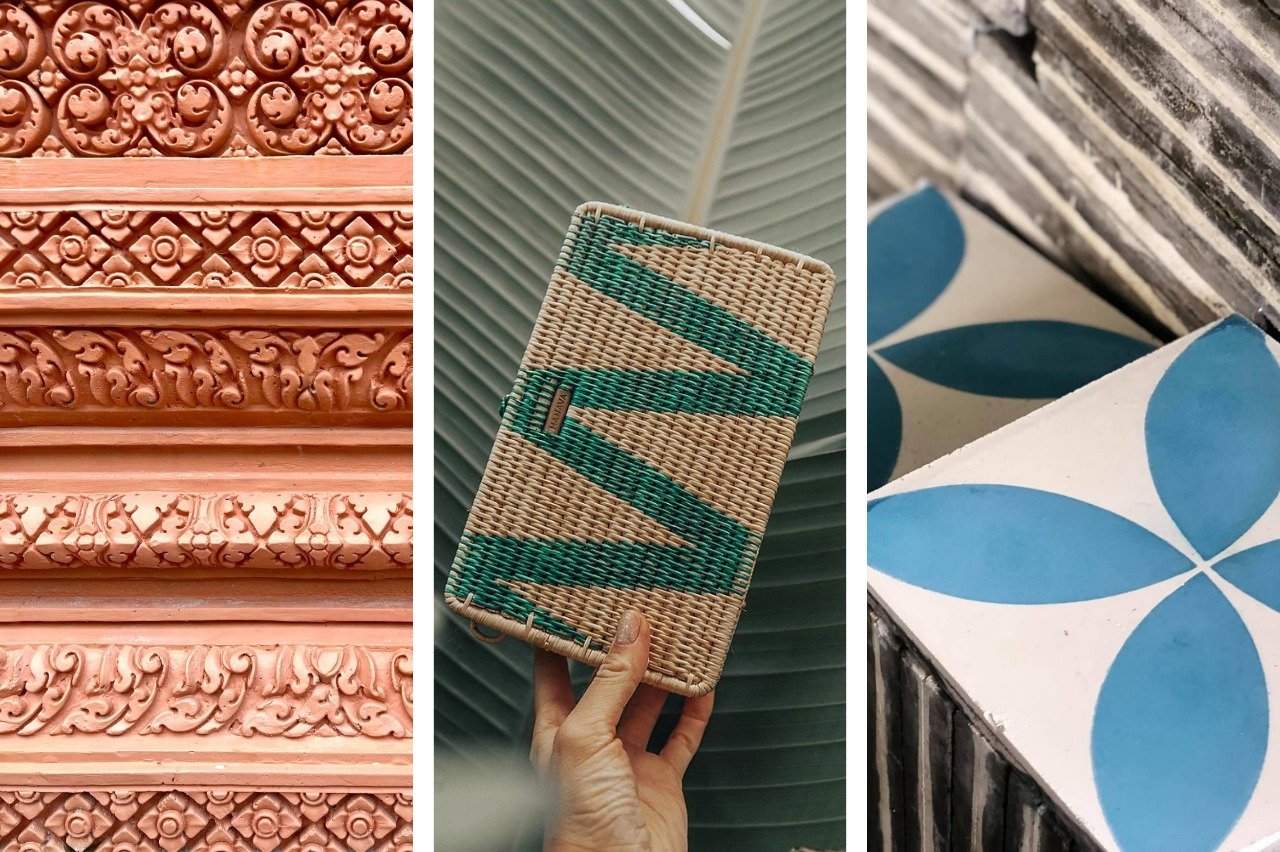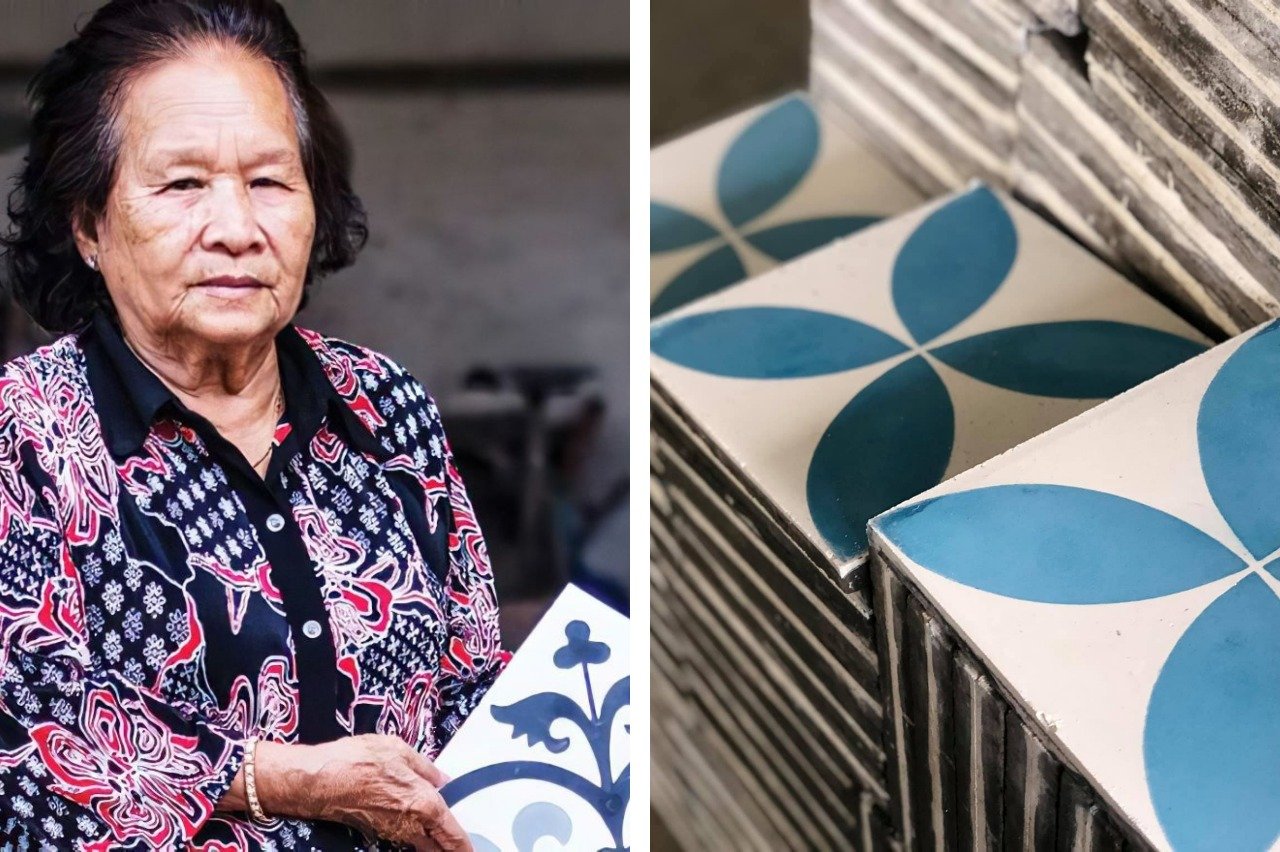With March being Women’s History Month, we blend our love for design and diversity into this month’s feature to shine a light on the inconspicuous world of material design in Cambodia. Read on to discover surprising stories of wonderwomen across our community and their work, from tile manufacturing to reimagining homeware production.
Materials matter to us. While ‘material design’ sounds clinically technical and far away from our everyday lives, we care about it on those days when our itchy sweaters irritate us to no end or we trip on a damaged tile in the hallway. Materials play a role in complementing our country’s architecture and interiors too. Ultimately, they are the foundation of great products, without which consumers would have no choice but to default to using cheap, poor quality, imported items.
Photos courtesy of Manava and Taing Heng Sreng
As more products are proudly labelled ‘Made in Cambodia’, we wanted to celebrate people who are making contributions to this movement. We showcase women in our community who are often working behind the scenes to develop great materials in-country. Our roundup features five female entrepreneurs in the country who pushing their respective craft and consciously empowering women in the workforce.
Setha Leakhena: Reimagining modular homes with sustainable materials
Phnom Penh born architect Leakhena has been obsessed with modular system design for over a decade before founding Niron House in 2019. The pilot project exemplifies how local reclaimed wood can be used to create versatile and more sustainable living solutions in Cambodia.
Photos courtesy of Niron House
Wood makes up 90% of each home, with the rest coming from other materials that are naturally occurring and energy-efficient. All materials used can be found within the community, keeping costs as affordable as possible. As ways to treat wood in the country are limited, Leakhena uses high-quality imported coating on the lumber in order to lengthen its lifespan. Niron House’s prefabrication also means that it’s quick to deploy, easy to assemble, and requires minimal skilled labour. Tailored to meet the demands of tropical climate, the design includes natural ventilation and shades, accommodating both visual and thermal comfort. For more info, visit nironhouse.com.
San Vannary: Weaving surprising silk from banana stems and cotton fruits
Vannary embarked on her entrepreneurial journey in 2003 with just one sewing machine. Two decades later, she has two enterprises to her name, employs 10+ weavers, and partners with multiple rural communities across the country to create sustainable fabrics.
Photos courtesy of Lotus Silk
Her first venture, Lotus Silk, is an ethical and environmentally-conscious spin on textile production. Vannary goes the extra mile to bring locally grown products in her work as part of her mission to support rural communities. This includes experimenting to see how soft fibres can be extracted from banana stems using lye, an alkali solution used to smoothen fibres. Her latest venture even showcases all the knowledge and processes accumulated over the years - a museum called ‘Silk House’. Located in Phnom Penh, visitors can learn more about the process of Khmer traditional textile manufacturing. Pop by the gallery on St. 371 to see her work up close and in-person.
Chan Ka-Lai: Refining hand-sewn ‘kontrok’ baskets with artisans, for the world
Trained product designer and friend of Raintree, Ka-Lai co-founded Manava in 2016 in her aspiration to create stunning homewares made with locally sourced materials while also developing rural Cambodian artisans. Manava means ‘humankind’ in Sanskrit, so we’re not at all surprised by the extent to which Ka-Lai and her team put people at the heart of their design.
Photos courtesy of Manava
The venture supports 20+ female artisans to pursue their craft full-time while also receiving training to develop their skills, both professional and personal such as English, personal finance management, and family planning. From fashion accessory to furniture, each piece is handwoven with 'pdau' rattan or 'la paek' willow grass and often incorporates 'kbach' Khmer motifs to reference the origin of the pieces. Manavav pieces are appreciated across the world, being stocked by retailers in Europe and Asia. For more info, visit www.manava-cambodia.com.
Oum Sophea Pheach: Recreating golden silk with 100% natural supplies
Spanning across hectares just outside of the infamous Silk Road in Siem Reap lies Golden Silk, a project that aspires to revive the traditional ‘sot meas‘ silk-weaving art of Cambodia. It was founded and is currently managed by Pheach, the former Director of the National Centre of Cambodian Silk.
Photos courtesy of Golden Silk
There is a real human touch at every step of the process at Golden Silk, from breeding golden silkworms to natural dyeing, to weaving by hand. Pheach explains this ensures the project delivers the highest quality of traditional textile, as it is a craft of accuracy, precision, and patience. In their aspiration for authenticity, plants and raw materials surrounding Angkor Wat are sourced and transformed into natural pigments to colour the fabrics. The silk is soaked in a bath of natural dyes to give the natural thread a bright colour and velvet touch. For more info, visit goldensilk.org or book a tour today at 012 596 811.
Sim Lang: Preserving tile craftsmanship with unique Khmer prints
Fewer interior design details demonstrate that a house in Cambodia was built during the Sangkum period (1955-1970) the ways tiles do. Known as encaustic cement tiles, they were introduced to the country by the French, but have been so widely adopted in the era that many people now consider them as part of Cambodian design.
Photos courtesy of Phnom Penh Post and Taing Heng Sreng
Coming from a family of tile makers, Sim Lang picked up the craft when she was in her early 20s. She’s the current owner of Taing Heng Sreng, the only known tile production workshop that is still in operation in Phnom Penh today. With the passing of her partner, Lang now holds the cumulative knowledge of the family trade and has been actively working to pass down everything she knows to her son, who’s managing the operations of her workshop on a daily basis. In recent years, we've noticed architects and designers are starting to increasingly appreciate locally produced materials like these cement tiles. With this, we hope to see even more workshops like Taing Heng Sreng emerge in the market to innovate, pushing boundaries to create even more unique and longer-lasting products than can be adopted by projects across Cambodia.
***
We are excited by how these entrepreneurs think deeply about how they use their craft as a vehicle to drive our economy and culture forward. Representation matters, and we truly believe that with these women paving the way in the workforce, we hope it brings a ripple effect where other women are inspired to embark on their own pathway. With the celebration of Cambodian culture through their work, we also hope that more creatives are inspired to push boundaries to develop Khmer culture into their respective disciplines, whether it’s graphic design, writing, or any other field.
Follow us on social media @raintreecambodia to get short, interesting stories about the world of design, architecture and culture in your newsfeed every week.






